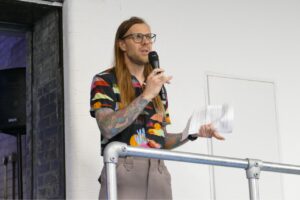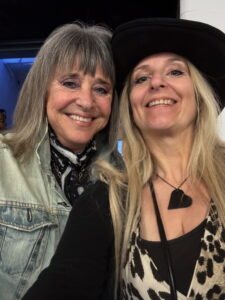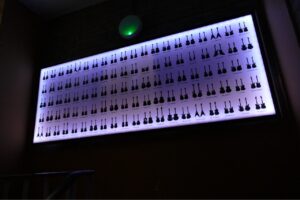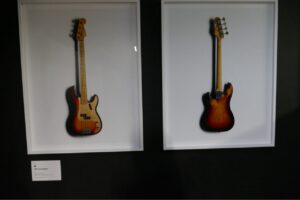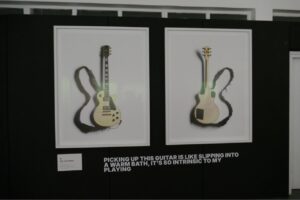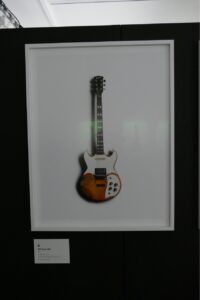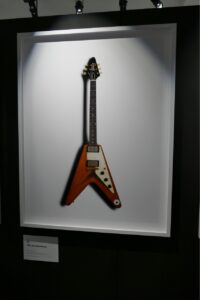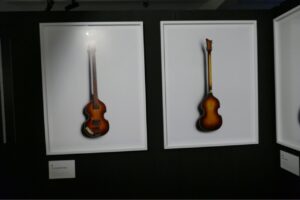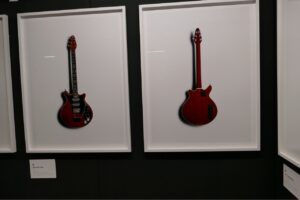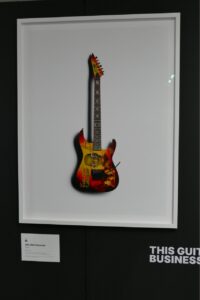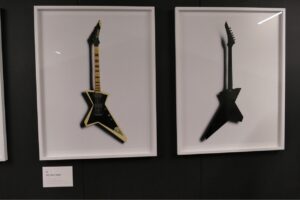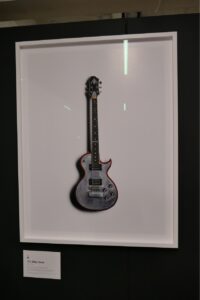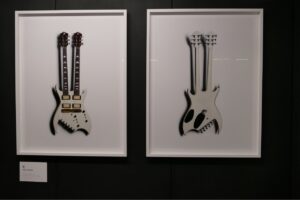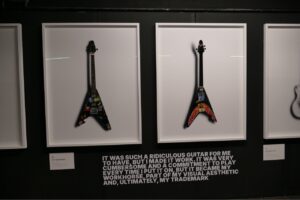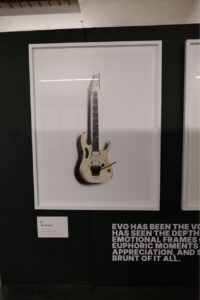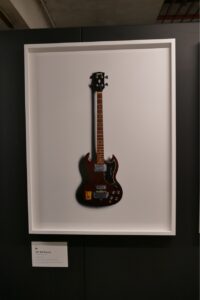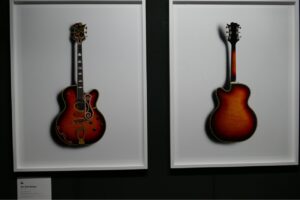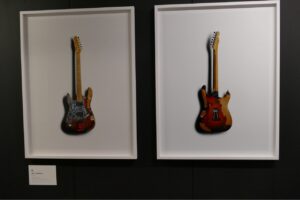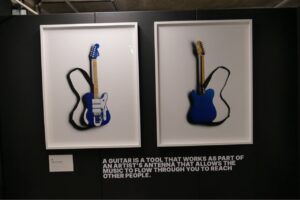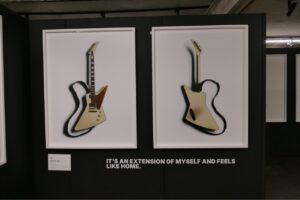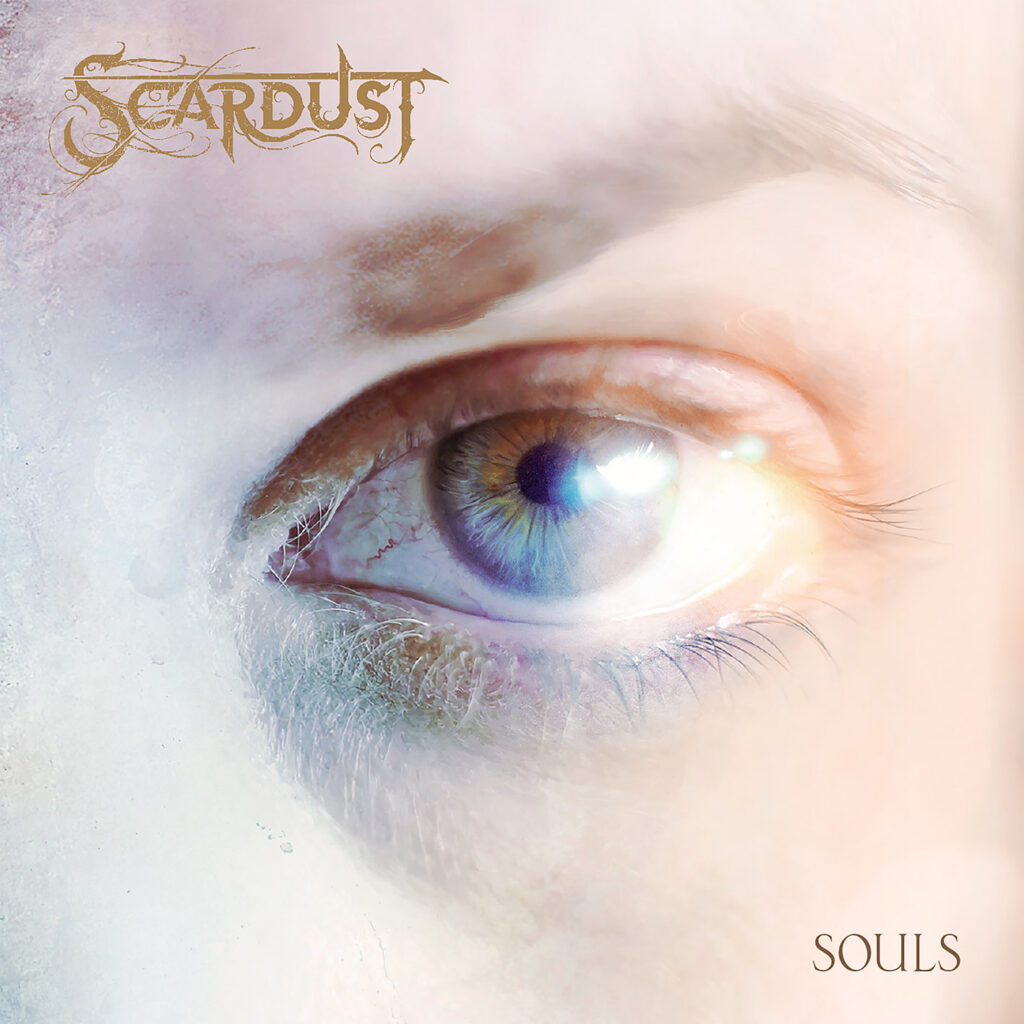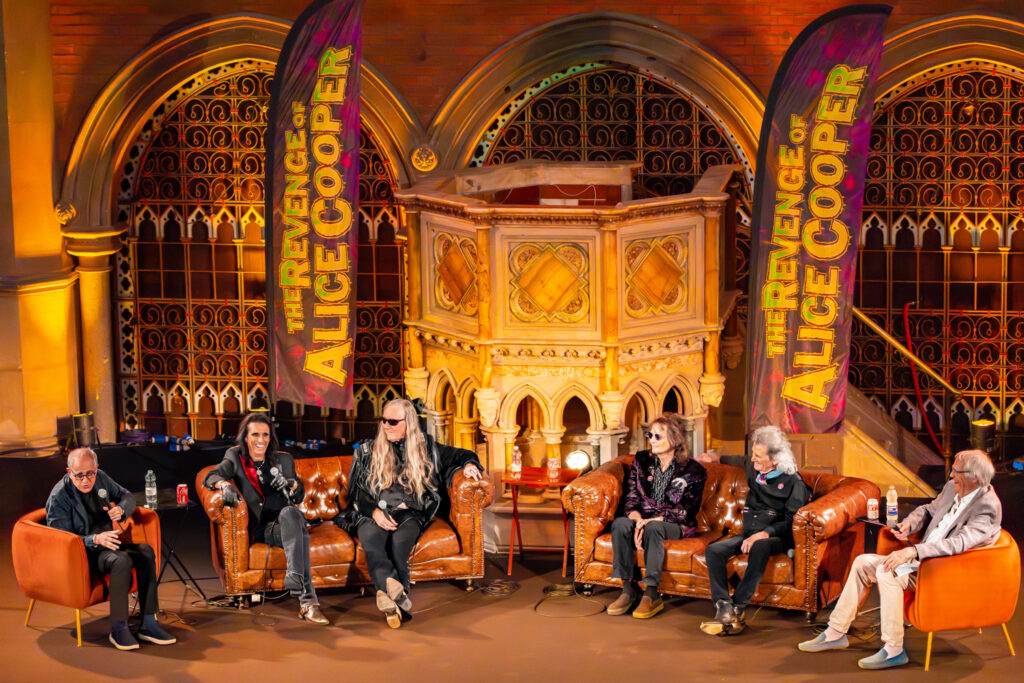Scale Exhibition of Guitars and Guitar Stories – by Dawn Osborne
Written by Dawn Osborne on June 14, 2025
Members of the London Rock Press, featured artists and luminaries gathered for a special preview of the Scale Photography Exhibition of 1:1 lifesize photos of the front and back of some of the most prized guitars in the world which has been over ten years in the making. Kane Hibberd has travelled the world persuading some of the most famous guitarists and bassists in the world to allow him to photograph their instruments and tell him their stories. Over 20 hours work was involved in just preparing each print and there are two, a front and a back to each guitar. Images of over 300 guitars were collected and the exhibition, currently open in Shoreditch, London features 100 of those. Hibberd was overcome by emotion explaining what the opening day of the exhibition meant for him and his family. He is hoping the exhibition will, in turn, travel across the world.
Instant gravitas and glamour was brought to the proceedings by artists present at the exhibition including Suzi Quatro and Bruce Welch of The Shadows. It was lovely to see such legends turn up and have their photographs taken with their guitars. It was particularly personally pleasing to see Suzi again, who I have interviewed and photographed a few times before and who is such an icon for so many reasons. Couldn’t resist a selfie!
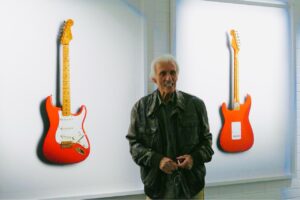 I was mildly interested to see the exhibition, but it wasn’t until I saw the photographs and got a headset and started listening to the stories of the guitars that it really drew me in. I only listened to a dozen or so and I was one of the last to leave I was so engrossed. Each guitar has a brief into, a more detailed story and a quote from the artist as to what their instrument would say if it could talk.
I was mildly interested to see the exhibition, but it wasn’t until I saw the photographs and got a headset and started listening to the stories of the guitars that it really drew me in. I only listened to a dozen or so and I was one of the last to leave I was so engrossed. Each guitar has a brief into, a more detailed story and a quote from the artist as to what their instrument would say if it could talk.
Suzi Quatro chose her 1958 Fender Precision bass, an enormous instrument compared to her small frame. Bought in 1973 to replace a stolen one: it was her touring bass 1974-1977 for “big crazy gigs” supported by KISS and Blue Oyster Cult and for sold out shows in Australia. It was retired in 1977 as she didn’t want to lose a second one and she had a BC Rich endorsement. If her bass could speak to her she said it would say “Thanks for finding me, Suzi”. She still wants to get her original back if you know where it is (stolen in 1969 in Hanoi).
I am writing this up on my way to Download so it is very fitting that Justin Hawkins was also featured in the exhibition. He chose his 2003 Gibson Les Paul Custom. He wanted to be “the white Les Paul guy” because of players he admired like Luke Morley (Thunder). It arrived in time for the recording of The Darkness’ Christmas song at Abbey Road and has been part of his rig ever since. It has some scars from when it was crushed by a lighting rig, its headstock has been smashed off and it has hit the low hanging ceiling of many venues, but Hawkins feels it is part of him and irreplaceable and that one day they will still be looking out over sunsets together.
Dave Hill of Slade chose his Sam Lee custom “Dad’s guitar” paid for by his father with a month’s wages from Sound City on Shaftesbury Avenue. It has unique pick up that defined the sound of Slade and was used for all their number ones and made his dad very proud when he saw it played on telly.
Joan Jett of the Runaways chose her 1965 Gibson Melody maker, a “stunt double” for her original from the Runaways. Years of cigarette smoke in venues have turned it yellow and it is covered in stickers that all mean something personally. It was used for ‘I Love Rock ‘n’ Roll’ and ‘Bad Reputation’ and to play ‘Smells Like Teen Spirit’ with Nirvana. If it could talk her guitar would say “Do it Again!”
Captain Sensible chose his 1971-1972 Gibson SG “it could be fake I couldn’t care less”. It has been set on fire, attacked with an axe and was used to smash a whole wall of mirrors. Sensible believes it saved his life as when he broke a rib falling on top off it off stage the hospital found cancer in the scan, caught early enough to be cured.
Joe Bonamassa chose his 1958 Gibson Flying V. The guitar had belonged to the gospel singer Gino Landry and had been found in a trash bag by Landry’s niece who would have sold it for $500 if she had not been advised how much it was worth. The strings had not been changed for 40 years. The lady would only accept cash and Bonamassa was on tour. He got a few friends to turn up with 200K cash between them to secure the guitar before the lady sold it to someone else. It has been played at Red Rocks and the Royal Albert Hall and has its own seat on plane rides. Because it is not in perfect shape it can be played. It is very happy to have been given a second chance in life!
Paul McCartney chose his 1963 Hofner 500/1 played for the Royal Variety Show. It has Strat buttons, but otherwise has never been modified, but needed to be repaired after it fell through a trap door in Tampa. He also takes it with him inside planes. If it could talk it would say to him “we’ve seen some stuff haven’t we”.
George Thorogood’s Gibson faded by the sun from a pawn shop window where it was purchased has been stolen twice and returned twice for a reward and is now only used for the studio as it’s getting fragile. It’s thin neck is good for Thorogood’s small hands. After he threatened his guitar techs with a fine if it was stolen it was never stolen again. It it could talk it would say “give me a break, get another guitar”.
Brian May chose his 1965 Red Special built by him and his father out of a fireplace, a table, buttons and matchsticks. It has been used on all of Queen’s recordings. To him it represents “unconditional love”.
Kirk Hammett chose his 1996 ESP KH2 “The Mummy” adorned with graphics from the 1932 Boris Karlov film. Only 5 were made all for him, with special eye of Horus fret markers and it was never commercially made. This is the second and he has “sweated, spat and bled all over it” which has seasoned the wood and its resonance is different from the others. He always plays it on ‘Enter Sandman’. If it could talk it would say “Don’t put me in a sarcophagus, keep me alive with the living!”
Glenn Tipton chose his mid-eighties Hamer GT Custom which was built for him with a long tailstock to sit on his leg and an emblem he designed at the bottom. There were three, one of which was stolen at JFK and he would like to have it back! He wrote ‘Painkiller’ and many other Judas Priest songs on it. If it could talk it would say “Thank you for all the wonderful memories together”.
Gilby Clarke chose his 1992 Zemaitis Custom Shop Deluxe Silver Top, the same template as Ron Wood’s whose he had seen and admired. The luthier interviewed him, before he agreed to make him a guitar. Only ten Zemaitis guitars were made a year and Marc Bolan and Jimi Hendrix played them. It was used for the Guns n Roses ‘Use Your Illusion’ tour and for most of the stuff Clarke did for them. When the headstock broke off in an accident Zemaitis repaired it, but since Zemaitis passed Clarke only uses it on special occasions.
Lita Ford chose one of the most striking guitars in the exhibition her 1981 BC Rich Rich Bitch Double Neck, a custom prototype made for her with a smaller body than usual because she is only 5’5”. It still weighs 15 pounds and she has a special lambswool padded strap to help distribute its weight. It enables her to play the acoustic intro to ‘Close My Eyes Forever’ and the big solo in it without compromising tone and without effects pedals. She calls it the twins and if they could speak they would say “Mama pour me a whisky”.
Nuno Bettencourt chose his 1991 Washburn N4 custom. It was retired after someone tried to steal it and it now feels like a home he used to live in. It is like a limb and represents the longest relationship ever, a partner and a security blanket. It has been slung over Brian May’s shoulder and played by Eddie Van Halen. If it could speak it would say “Thanks for the ride”.
Donita Sparks chose her 1970s Ibanez which she called her flying vagina. It is both worthless and priceless. It was given to her as payment for rent. It was beaten up and perfect for her, it was covered in blood, sweat and shaving cream, but was never the same after its headstock was broken off and is now retired. When in doubt during a solo she used to hit its whammy bar.
Steve Vai chose his 1993 Ibanez Gen 7VWH “EVO” designed by him in the eighties with white/gold hardware and named after a Harley Davidson engine. When Vai jammed with Les Paul he signed it, and signed it again after it wore off, but even plastic couldn’t preserve the signature which wore off again. When its pick ups were replaced Vai didn’t like it and they had to go through garbage to find the old ones to reinstate them. It has been privy to all his secrets, highs and lows and millions of notes. Vai sees it as a tool to express the inspiration he gets from the universe.
Bill Wyman chose his 1967 Gibson EB3. He gave it to a sculptor and thought it would be destroyed in the process, but the sculptor preserved it and returned it to him. If it could talk it would say “Thanks for keeping me in one piece, a true survivor of Rock ‘n’ Roll.
Rick Nielsen chose possibly the most unusually designed guitar a 1963 Guild Merlin Travis. Pete Townsend played one, but only three existed. He got it from a repair shop after someone threw it in a fireplace. It was in pieces, but was original and they were all there. He paid 5K for it, and 5K to have it restored which took six months. Nielsen had a version of the design transposed onto his car. If it could talk it would say “Thank you for rescuing me, but how come you didn’t get a better price”.
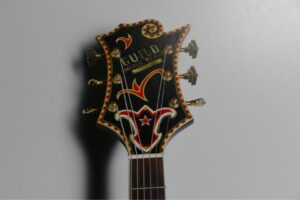 Joe Perry chose a 2000 Fender Frankenstrat. It has no email number only the date and place it was built. It has been scorched and in a freezer. It is his “go to guitar” used for all his Aerosmith, solo and Hollywood Vampires stuff. It talks to him every time he picks it up.
Joe Perry chose a 2000 Fender Frankenstrat. It has no email number only the date and place it was built. It has been scorched and in a freezer. It is his “go to guitar” used for all his Aerosmith, solo and Hollywood Vampires stuff. It talks to him every time he picks it up.
Jack White chose his 2022 Fender Triplecaster which continues to evolve as he seeks the perfect guitar. It has three pick ups, three ways to bend notes and comes in three colours. The body is ash and the neck maple. It has a scalloped fretboard as favoured by Ritchie Blackmore. If it could speak it would say “It’s time for my smoke break”.
Lzzy Hale chose her 2012 Gibson Explorer signature. She only got it as someone had to sell it for medical bills, but that person loves that it now tours all over the world. It makes her feel like “everything’s gonna be ok even if I am not”. It has a huge gouge where her brother’s high hat fell on it “but every scar is a reminder of the journey”. It had to be white even though that is the hardest colour to maintain. She cut her finger and bled all over it so the guitar literally has her dna all over it. The white strap with a Halestorm logo is old and frayed, but she will use it till it actually breaks beyond repair.
So I managed 21 audio narratives in a couple of hours leaving 80 still to go. This exhibition was fascinating for its insight, not only into guitars, but also the psyche of musicians and their instruments. Emotions like nostalgia and anthropomorphisation of objects are things that are universal that everyone can relate to. So this exhibition combines both the familiar and the otherworldly considering the amazing human beings that have all collaborated to make it up. Intimate and yet rarified. I was drawn by the stories into other world. Not just for guitar nerds, also for fans of the artists featured and for everyone who lives and has to navigate this material world. Highly recommended!
Dawn Osborne




